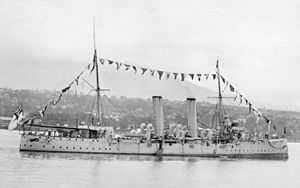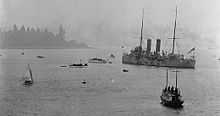HMCS Rainbow (1891)
 HMCS Rainbow in 1910 | |
| Career (United Kingdom) | |
|---|---|
| Name: | Rainbow |
| Builder: | Palmers, Hebburn |
| Launched: | 25 March 1891 |
| Commissioned: | 1893 |
| Decommissioned: | 1909 |
| Struck: | 1909 |
| Fate: | Transferred to Canada |
| Career (Canada) | |
| Name: | Rainbow |
| Commissioned: | 4 August 1910 |
| Decommissioned: | 1 June 1920 |
| Struck: | 1 June 1920 |
| Fate: | Scrapped 1920 |
| General characteristics | |
| Class and type: | Apollo-class protected cruiser |
| Displacement: | 3,600 tons |
| Length: | 314 ft (95.7 m) |
| Beam: | 43.5 ft (13.3 m) |
| Draught: | 17.5 ft (5.3 m) |
| Speed: | 19.75 knots (36.58 km/h) |
| Complement: | 273 to 300 (Officers and Men) |
| Armament: | 2 × QF 6-inch (152.4 mm) guns 6 × QF 4.7-inch (120 mm) guns[1] |
HMCS Rainbow, formerly HMS Rainbow, was an Apollo-class protected cruiser built for Great Britain's Royal Navy by Palmers at Hebburn-On-Tyne in England. She was launched on 25 March 1891 as HMS Rainbow and entered service in 1893. She was transferred to the Royal Canadian Navy in 1910 and scrapped in 1920.
Operational history
Royal Navy
Rainbow would serve in the China Station in Hong Kong from 1895 to 1898 and in Malta from 1898 to 1899. She had an operating cost that was deemed excessive and between 1900 and 1909, saw very little service. Most of her operations at this time were closer to England. On 17 December 1901 she was commissioned at Devonport by Captain Thomas Young Greet for service in the cruiser squadron as an additional ship in home waters.[3] She arrived back at Devonport from a tour of the Mediterranean with the squadron in April 1902.[4] During the following years, she saw a severe reduction in fleet support due to her high operating cost, resulting in only minor modernization. Her crew rotation at this time was used as a training cycle. Eventually, she was not used at sea at all from 1907 to 1909. In early 1909, the Admiralty ordered her decommissioned and placed on the inactive list.
Royal Canadian Navy
Rainbow was presented to Canada in 1910, and was recommissioned HMCS Rainbow on 4 August. She and HMS Niobe were purchased from the Admiralty to be used as training ships at Royal Naval College of Canada in Halifax, Nova Scotia.[5][6] During discussions on the type of cruisers to be sent to Canada, the Admiralty believed that the Apollo-class cruiser was the right choice.[7] Canada paid $225 000 to acquire Rainbow, using outstanding money from the Marine and Fisheries Department.[8] Before departing Great Britain, the ships required alterations to make them suitable for training. This required new heating systems, an up-to-date galley, the latest in Marconi wireless, the enlargement of the cadet gunroom and principal messes and the removal of the obsolete secondary armament.[6]
After commissioning, Rainbow was assigned to the west coast of Canada and was the first Canadian ship to sail around South America by the Strait of Magellan.[6] She arrived at Esquimalt, British Columbia on 7 November 1910. However after commissioning, the status of the Canadian vessels and their ability to operate without direction from the Admiralty kept the new ships within coastal waters. This limited Rainbow to fisheries patrols until the matter was settled.[9] Her service was quiet on the west coast, performing ceremonial duties,[10] training and coastal fisheries patrol, notably apprehending the American fishing schooner Edrie in February 1913 for illegal fishing.[11] When Niobe was laid up in 1913, her crew was sent west to fill out Rainbow 's complement.[12]

In July 1914, Rainbow was called to Vancouver to assist with an international incident that was unfolding. Komagata Maru, a Japanese merchant ship filled with Sikh immigrants from India, challenged Canada's immigration law, designed to prevent immigration from South Asia. The ship's passengers were not permitted to disembark even though they were British subjects. After the local authorities were rebuffed in their attempts to make the ship leave, Rainbow was ordered to intervene. After some discussion with the passengers, who had taken over the vessel, those aboard Komagata Maru agreed to leave Vancouver only when supplies for the ship were provided.[13] Twenty of the passengers were killed upon returning to Budge Budge, India, after they resisted an attempt to forcibly return them to Punjab.[14]
When the First World War broke out, Rainbow was sent to cover the withdrawal of the British sloops, HMS Shearwater and HMS Algerine, who had been engaged protecting British citizens during civil unrest in Mexico.[15] She was the largest armed ship the Allies had at the time in the western Pacific Ocean and was ordered to find and engage ships of the Imperial German Navy in the Pacific Ocean; in particular SMS Leipzig and SMS Nurnberg. She never met either of these ships, although she missed Leipzig by only a day at San Francisco.[16] She remained the only source of protection for shipping in western North America until the arrival of the Japanese armoured cruiser Izumo.[17] Following the destruction of the German Pacific Fleet at the Battle of the Falkland Islands in December 1914, the greatest threat to shipping in Pacific was considered to be armed German raiders and Rainbow was considered to be a match for all but the fastest.[18] However in 1915, her patrols were shortened due to the lack of a collier to refuel Rainbow while out on patrol.[19]
In early 1916, Rainbow was still patrolling the west coast of North America, performing reconnaissance on German shipping. On 23 April 1916, she seized the German-owned but American-flagged schooner Oregon and then followed that up by seizing the Mexican-flagged schooner Leonor.[20] In 1916 and early 1917, Rainbow was used to transport $140,000,000 in Russian gold bullion (valued in 1917 Canadian dollars), between Esquimalt and Vancouver.[21] This money was placed in trust with Canada by the Russian government for protection due to the impending Russian revolution.
The Royal Canadian Navy found that the cost of operating Rainbow was using up too much of the West Coast naval operations budget, and the crew of Rainbow were sorely needed on the Atlantic coast for the fight against the U-boats. Rainbow was decommissioned and de-activated on 8 May 1917, her crew sent east. On 5 July she was recommissioned in Esquimalt as a depot ship. She served in this capacity until 1 June 1920, when she was sold for scrap to a Seattle shipbroker.[10]
Commanding officers
- Captain Thomas Young Greet, RN 17 December 1901 -
- Commander J.D.D. Stewart (RN) 4 August 1910 - 23 June 1911
- CDR Walter Hose (RN then RCN) 24 June 1911 - 30 April 1917
- CDR H.E. Holme (RCN 1 May 1917 - 8 May 1917
- Lieutenant Commander J.H. Knight (RCN) 1 July 1917 - 21 August 1917
- CDR J.T. Shenton (RCN) 22 August 1917 - 12 May 1918
- Lieutenant Y. Birley (RCN) 13 May 1918 - 14 October 1919
- Captain E.H. Martin, CMG, (RCN) 15 October 1919 - 1 June 1920
Notes
- ↑ Admiral Percy Scott quotes 6 × 4.7 inch guns on sister ship HMS Scylla in 1899. "Fifty Years in the Royal Navy" published 1919, page 88
- ↑ Tunnicliffe 2006
- ↑ "Naval & Military intelligence" The Times (London). Wednesday, 18 December 1901. (36641), p. 6.
- ↑ "Naval & Military intelligence" The Times (London). Thursday, 1 May 1902. (36756), p. 6.
- ↑ MacMillan-Murphy, Jim. "Esquimalt Remembers" Esquimalt Heritage Advisory Committee. Retrieved 20 July, 2013
- ↑ 6.0 6.1 6.2 Johnston et al. pp.233-234
- ↑ Johnston et al. pp.225
- ↑ Johnston et al. pp.226
- ↑ Johnston et al. pp.242
- ↑ 10.0 10.1 Macpherson, Ken; Barrie, Ron (2002). Warships of Canada's Naval Forces. St. Catharines: Vanwell Publishing Limited. p. 11. ISBN 1-55125-072-1.
- ↑ Johnston et al. pp.267
- ↑ Johnston et al. pp.297
- ↑ Johnston et al. pp.298-299
- ↑ Ricketts, Bruce. "The Komagata Maru Incident". Mysteries of Canada. Retrieved 30 August 2013.
- ↑ Johnston et al. pp.299
- ↑ Milner, Marc (May–June 2004). "The Original Rainbow Warrior". Legion Magazine. Retrieved 3 December 2009.
- ↑ Johnston et al. pp.311
- ↑ Johnston et al. pp.321
- ↑ Johnston et al. pp.437
- ↑ Johnston et al. pp.438
- ↑ Sugrue, Clare (2005–2006). "Ship histories: HMCS Rainbow". CFB Esquimalt Naval & Military Museum. Retrieved 3 May 2007.
References
- Johnston, William; Rawling, William G.P; Gimblett, Richard; and MacFarlane, John. (2010) The Seabound Coast: The Official History of the Royal Canadian Navy, 1867-1939. Volume 1; Toronto: Dundurn Press. ISBN 978-1-55488-908-2
- Macpherson, Keneth R. and Burgess, John. (1982)(Second Printing)The Ships of Canada's Naval Forces 1910-1981. Collins Publishers. ISBN 0-00-216856-1
- Tunnicliffe, Mark. "Research Note. Rainbow’s Guns - What and When?", in The Northern Mariner/Le marin du nord, XVI No.3, (July 2006)
External links
| Wikimedia Commons has media related to HMS Rainbow (ship, 1893). |
A City Goes to War - www.acitygoestowar.ca This web site from the University of Victoria includes an excellent account of HMCS Rainbow. https://onlineacademiccommunity.uvic.ca/ssprincesssophia/
| ||||||||||||||||||